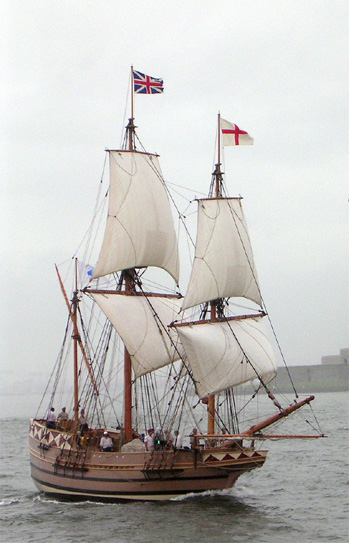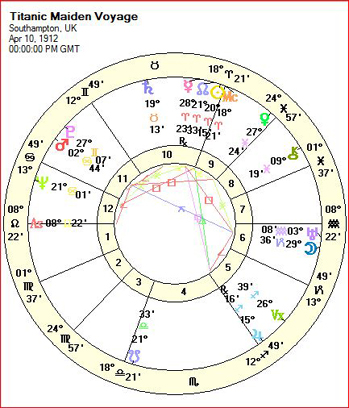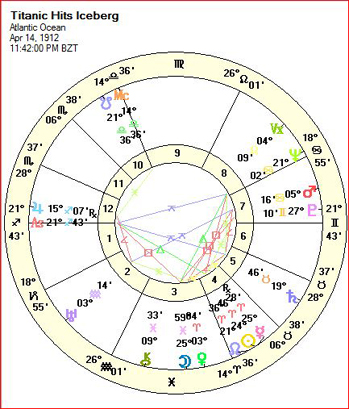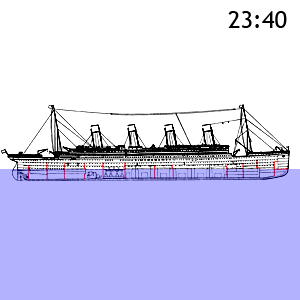By
John Townley, April 2012
A lot has been written on the RMS Titanic, especially now around the centennial of its
premature
demise, and that includes a generous amount of astrological
speculation,
including a whole book on it a
while back.
Was it star-crossed from the beginning? Was it just a badly-aspected
voyage
that resulted in a fluke accident? Was it an angry Neptune, a fractious
Uranus,
an intractable Pluto, or a cross Mars or Saturn that did in the White
Star
liner? Or a mix of all of the above?
Before the outer planets were every
discovered, when ship
travel was the main mode of world commerce and transportation, maritime
questions
were a major part of an astrologer’s work. Seventeenth century
astrologers like
Lilly, Gadbury, and Partridge at the height of the age of exploration
wrote
extensively on the subject, much of it well worth reading
today.


In the day of the
original 17th century Godspeed,
astrologers kept a watch eye on ships, but it failed to save her
replica...
I had the adventure of becoming the
closest thing to being
one of them when in late 1984 I was engaged by Captain George Salley,
commander
of the replica of the 1607 Jamestown voyage ship Godspeed,
to be the project's official period doctor and astrologer.
The 1985 voyage had a modern doctor on board (and needed one, when one
of the
crew had to be helicoptered off in the English Channel due to terminal
seasickness), so my landside tasks were more theoretical, including
doing the
charts of all the crew, the ship’s keel-laying, launch,
commissioning, and initial
voyage. It afforded me the opportunity to immerse myself in period
astrology
and medical works, which were intimately entwined. It was fascinating,
and
rather disturbing as I watched one event after another go down with
dreadfully-afflicted charts, from the keel laying onwards. Saturn,
Mars, and
Pluto were everywhere afflicting the Lights and Angles, each time, and
the ship’s
progress reflected it. Interminable delays, disputes over funding and
authority, and failure of materials and equipment all plagued the
operation.
After a late start, six weeks fighting
headwinds just to get
out of the English Channel, and a near-mutiny at sea between factions
of the
crew who wanted to stay with traditional historical sailing methods and
those
who just wanted to hurry up and get there with modern gear, half the
crew
deserted in the Caribbean after nearly being blown ashore in Puerto
Rico. The totally-modern
substitute modern crew, inexperienced with old sailing ship handling,
got it as
far as Cape Hatteras and was headed for the rocks when the Coast Guard
had to
take them in tow for the final leg of the trip to Virginia. All in all,
it was
a disaster that very closely followed the charts of the ship’s
preparations and
voyage. All I could do was advise and sympathize, as no one really took
my
predictions or warnings seriously. Too bad. I’ll have to write a
book about it
someday…or maybe better if I don’t.


Uranus and Pluto figure
strongly in disaster (times adjusted 2 min to correct for ship's
time/time zone standard)
So did the Titanic
have the same experience? Was she cursed by the stars from the get-go,
or did
she just fall afoul of momentary bad astral weather that was enough to
do her
in? From a general look, probably a bit of both, but especially the
latter, and
in a way that probably can be seen only in hindsight (unlike the Godspeed debacle, which might have been
prevented). In the chart of her maiden voyage, the Moon is
void-of-course, at
the degree where Uranus was at its launch and applying to the
conjunction to
Uranus, with Pluto on the anti-vertex. Then, when the iceberg was
struck,
Uranus was on the anti-vertex with Pluto square the Moon, and finally
Uranus
was on the Ascendant when in an enormously violent breakup she finally
sank
beneath the waves, as Pluto finished its square. As with so many
snowballing
accidents, early ordinary afflictions which normally might pass
conspired to
pile up as things got out of control. As an astrologer, I certainly
wouldn’t have
sounded any major warnings. Certainly a maiden voyage on a
void-of-course Moon could
be expected to be something of a disaster, but not usually one taking
1500+
lives, from passengers, to crew, right down to two hapless youths on
the Carpathia who fell overboard
rubbernecking the belated rescue.


A violent break-up, with
Uranus rising, marked the last moments of RMS Titanic as she sank beneath the
waves.
And of course one of the main reasons
for the continued
fascination of the still-compelling tale a hundred years later is that
the
mindset surrounding the ship simply didn’t admit the possibility
of disaster. The
ship, and the society and technology that built it, was too perfect,
too
powerful to perish. Indeed, the whole world was in much the same
condition, as
Pluto and Neptune hovered at the end of their signs, with only Uranus
breaking
through into Aquarius, suggesting something revolutionary was about to
occur.
Which it did, as in only two years, the too-perfect world was plunged
into the
biggest world conflagration since Napoleon. When all three outer
planets change
sign in swift order, order itself usually takes a big it, in this case
shifting the whole focus of world power in the direction of the ship's
ill-fated voyage, from Europe to America. Titanic was
a harbinger of a global order itself about to perish and
as such would fascinate the world for generations to come.
Titanic began to
change from a prophetic news story into a storied myth only a decade
later with
a still-familiar 1924 hit record by Virginia country singer Ernest
Stoneman
(hear/download another good Virginia
rendition here, from this CD),
and many books, movies, and a Bee
Gees
requiem later, it still lives in our memories as a parable of
hubris,
social injustice, and high drama, from the skies above to the waves
below...

Titanic's voyage was unrecognized
harbinger of world power shift from Europe to America.

